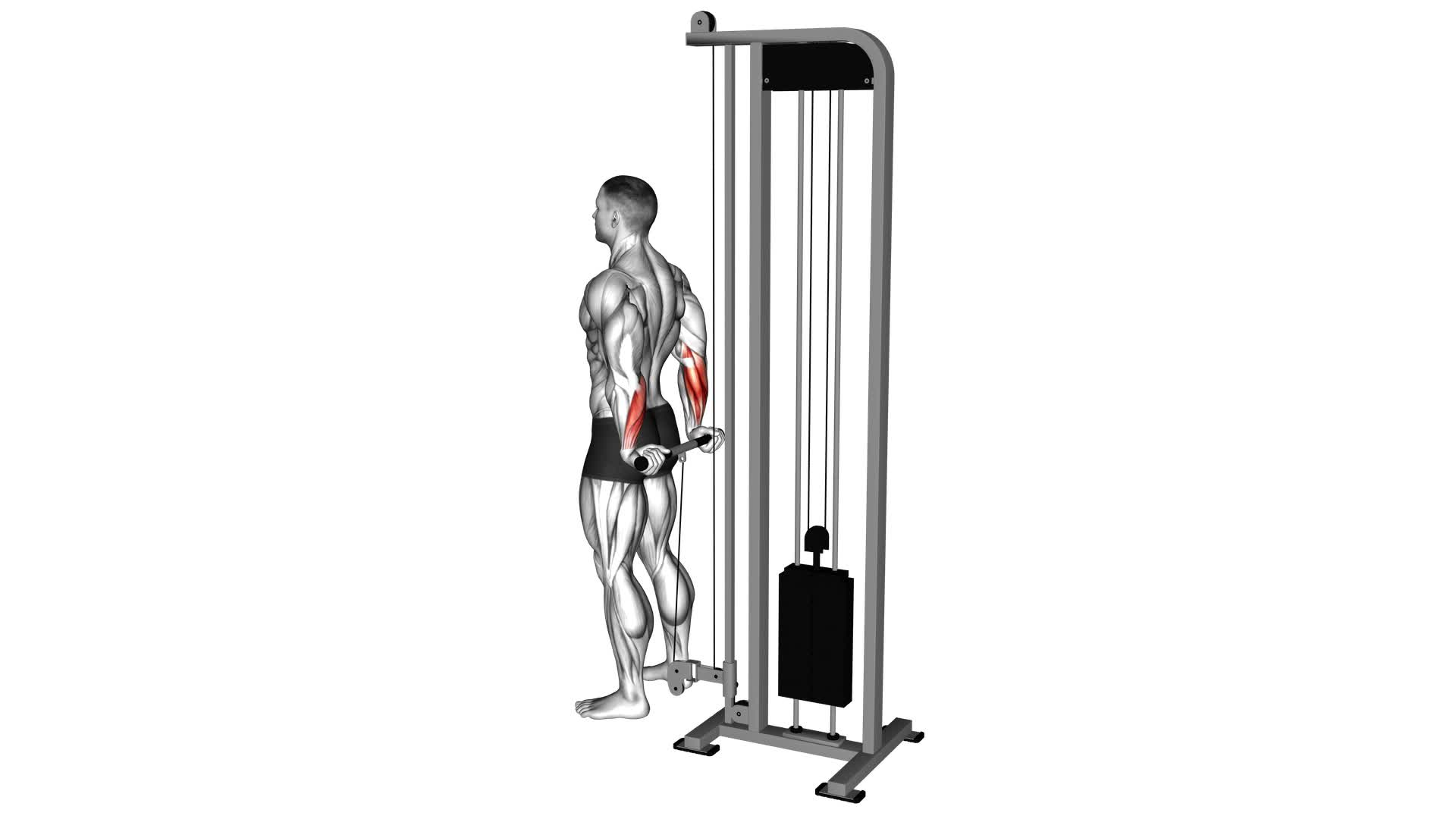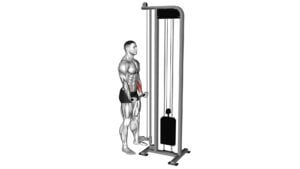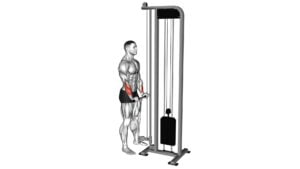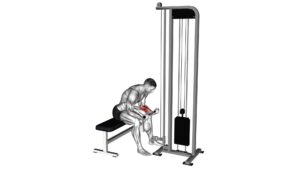Cable Standing Back Wrist Curl – Video Exercise Guide & Tips

Are you looking to strengthen your wrists? Look no further than the Cable Standing Back Wrist Curl.
Watch This Exercise Video
This video exercise guide will show you the proper form and provide helpful tips to maximize your results.
Set up the cable machine and follow the step-by-step guide for a quick and effective wrist workout.
Avoid common mistakes and get ready to see improvements in your wrist strength.
Let's get started!
Key Takeaways
- Cable standing back wrist curls strengthen the wrists and forearms.
- This exercise improves grip strength and enhances wrist stability.
- It can help prevent wrist and forearm injuries.
- Incorporating cable standing back wrist curls into your routine can increase overall strength and stability in the wrists.
Proper Form for Cable Standing Back Wrist Curl
To perform the Cable Standing Back Wrist Curl with proper form, hold onto the cable handle with your hand's palm facing up. This exercise is great for strengthening your wrists and forearms while also improving grip strength. It's important to maintain proper form to prevent injury and maximize the benefits of this exercise.
To begin, stand facing the cable machine with your feet shoulder-width apart and your knees slightly bent. Grab the cable handle with an underhand grip, keeping your elbows close to your sides. Your upper arms should be parallel to the floor, forming a 90-degree angle.
From this starting position, exhale as you curl your wrists towards your body, keeping your elbows stationary. Pause for a moment at the top of the movement, then inhale as you slowly lower your wrists back to the starting position. Repeat for the desired number of repetitions.
If you're looking for alternative exercises to target your wrists and forearms, you can try wrist curls with dumbbells or barbells. These exercises provide similar benefits and can be performed with different variations to target specific muscle groups.
Remember to always use proper form and start with lighter weights to avoid strain or injury. Incorporating these exercises into your workout routine can help prevent wrist and forearm injuries and improve overall strength and stability in these areas.
Setting Up the Cable Machine
You can set up the cable machine by adjusting the weight stack and positioning the cable handle at a suitable height. To ensure an effective workout and minimize the risk of injury, follow these steps:
- Adjusting weights: Start by selecting the appropriate weight for your fitness level. Most cable machines have a weight stack that can be adjusted by inserting a pin into the desired weight plate. Choose a weight that challenges you but still allows for proper form and control throughout the exercise.
- Positioning hands: Stand facing the cable machine with your feet shoulder-width apart. Grasp the handle with an overhand grip, palms facing down. Adjust the height of the cable handle so that it's level with your waist or slightly below. This will allow for a full range of motion and proper alignment as you perform the standing back wrist curl.
- Checking alignment: Before starting the exercise, make sure your body is properly aligned. Keep your back straight, shoulders relaxed, and core engaged. Maintain a slight bend in your knees to provide stability and prevent strain on your lower back.
Step-by-Step Guide to Performing the Exercise
After setting up the cable machine and ensuring proper alignment, proceed to perform the cable standing back wrist curl exercise. This exercise primarily targets the muscles in your forearms and wrists, helping to improve overall forearm strength.
To begin, stand facing the cable machine with your feet shoulder-width apart. Grab the handle with an overhand grip, palms facing down, and extend your arms straight out in front of you. Keep your elbows close to your sides throughout the exercise.
Next, exhale and slowly curl your wrists backward, pulling the handle towards your body. Keep your forearms stationary and only move your wrists. Hold the contraction for a brief moment, then inhale and slowly return to the starting position, maintaining control throughout the movement.
It is essential to perform this exercise with proper form and avoid using excessive weight, as it may strain your wrists. Start with a light weight and gradually increase as your strength improves.
Variations of wrist curls can be incorporated based on your fitness level and goals. For instance, using a dumbbell instead of a cable machine can provide a similar workout. Additionally, adjusting the grip width or using different hand positions can target different areas of the forearm. Experiment with these variations to find what works best for you.
Remember to consult a fitness professional if you have any concerns or questions.
Tips to Maximize Your Wrist Strengthening Results
To maximize your wrist strengthening results, it's important to focus on maintaining proper form and gradually increasing the weight as your strength improves. Here are some tips to help you get the most out of your wrist strengthening exercises:
- Choose effective wrist strengthening exercises: Incorporate exercises that target the muscles in your wrists and forearms, such as wrist curls, reverse wrist curls, and wrist extensions. These exercises help improve grip strength and enhance overall wrist stability.
- Understand the importance of wrist strength in sports performance: Strong wrists are crucial for athletes in various sports, including tennis, golf, and weightlifting. Having strong wrists can improve your ability to generate power and control in your movements, leading to better performance and reduced risk of injury.
- Listen to your body and progress gradually: It's important to listen to your body and not push yourself too hard, especially if you're just starting out or recovering from an injury. Start with lighter weights and gradually increase the resistance as your strength improves. This will help prevent overexertion and reduce the risk of strain or injury.
Common Mistakes to Avoid During the Cable Standing Back Wrist Curl
During the Cable Standing Back Wrist Curl, it's important to avoid the common mistake of gripping the cable handle too tightly. Many people tend to grip the handle tightly, thinking it will provide better control and stability. However, gripping too tightly can lead to unnecessary tension and strain in the forearm muscles, ultimately compromising the effectiveness of the exercise. To avoid this mistake, maintain a relaxed grip on the cable handle throughout the movement.
Another common mistake to avoid is using excessive weight. It's crucial to start with a weight that you can comfortably handle and gradually increase it as your strength improves. Using too much weight can lead to improper form and potential injuries.
Furthermore, make sure to maintain proper form throughout the exercise. This includes keeping your back straight, shoulders relaxed, and focusing on the movement solely in the wrists. Avoid any jerking or swinging motions, as they can put unnecessary stress on the wrists and increase the risk of injury.
Frequently Asked Questions
How Many Sets and Reps Should I Do for the Cable Standing Back Wrist Curl Exercise?
To progress in the cable standing back wrist curl exercise, you need to find the right sets and reps for your fitness level. Start with 2-3 sets of 8-12 reps and focus on proper form.
As you get stronger, gradually increase the weight and decrease the reps to challenge your muscles. Remember to listen to your body and take breaks if you feel any wrist pain.
Proper technique and gradually increasing intensity will help you avoid injuries.
Can I Use Dumbbells Instead of a Cable Machine for This Exercise?
Yes, you can definitely use dumbbells instead of a cable machine for the wrist curl exercise. Using dumbbells allows for a different range of motion and can help to strengthen your wrists and forearms.
However, it's important to note that using wrist wraps can provide additional support and stability during this exercise. Wrist wraps help to protect your wrists and prevent injuries.
Is It Necessary to Use Wrist Wraps or Any Supportive Equipment While Performing This Exercise?
When performing the cable standing back wrist curl exercise, using wrist wraps or supportive equipment isn't necessary, but it can provide benefits. Wrist wraps can offer added stability and support to your wrists, reducing the risk of injury.
However, it's important to focus on maintaining proper form and technique throughout the exercise. Keep your back straight, engage your core, and use controlled motions to target the muscles in your forearms effectively.
Can Beginners or People With Weak Wrists Perform the Cable Standing Back Wrist Curl Exercise?
Yes, beginners or people with weak wrists can perform the cable standing back wrist curl exercise. It's a great way to strengthen your wrists and forearms.
However, it's important to use proper form and avoid common mistakes like using too much weight or letting your elbows move during the exercise.
While weightlifting gloves can provide some support, they may not replace the need for wrist wraps, especially if you have weak wrists.
Are There Any Alternative Exercises That Can Also Help in Strengthening the Wrists?
There are several alternative exercises that can help strengthen your wrists. These exercises include wrist curls, reverse wrist curls, and wrist rotations.
By incorporating these exercises into your workout routine, you can improve wrist strength and flexibility. Strengthening your wrists can benefit you in various activities such as weightlifting, yoga, and even everyday tasks like carrying groceries.
Conclusion
In conclusion, the cable standing back wrist curl is an effective exercise for strengthening the wrists. By following the proper form and setting up the cable machine correctly, you can target the muscles in your wrists and see maximum results.
Remember to avoid common mistakes and use these tips to optimize your wrist strengthening routine.
Incorporate this exercise into your fitness routine to improve wrist strength and support overall upper body strength and stability.

Author
Years ago, the spark of my life’s passion ignited in my mind the moment I stepped into the local gym for the first time. The inaugural bead of perspiration, the initial endeavor, the very first surge of endorphins, and a sense of pride that washed over me post-workout marked the beginning of my deep-seated interest in strength sports, fitness, and sports nutrition. This very curiosity blossomed rapidly into a profound fascination, propelling me to earn a Master’s degree in Physical Education from the Academy of Physical Education in Krakow, followed by a Sports Manager diploma from the Jagiellonian University. My journey of growth led me to gain more specialized qualifications, such as being a certified personal trainer with a focus on sports dietetics, a lifeguard, and an instructor for wellness and corrective gymnastics. Theoretical knowledge paired seamlessly with practical experience, reinforcing my belief that the transformation of individuals under my guidance was also a reflection of my personal growth. This belief holds true even today. Each day, I strive to push the boundaries and explore new realms. These realms gently elevate me to greater heights. The unique combination of passion for my field and the continuous quest for growth fuels my drive to break new ground.







